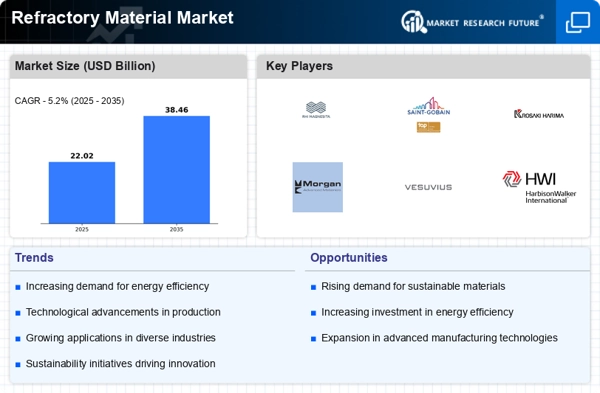Top Industry Leaders in the Refractory Material Market

The refractory material market, encompassing heat-resistant materials used in high-temperature applications, boasts a dynamic and ever-evolving landscape. With a projected CAGR of 5.2% for 2023-2032, the market attracts a diverse range of players vying for a piece of the pie. Understanding their strategies, market factors influencing share, industry news, and recent developments paints a vivid picture of this competitive arena.
Strategies Igniting Market Share:
Product Prowess: Leading players like RHI Magnesita, Saint-Gobain, and Morgan Crucible are constantly innovating. RHI Magnesita's development of ultra-high-performance magnesia bricks for steelmaking furnaces exemplifies this drive.
Geographical Gambit: Expansion into emerging markets like China and India is a key strategy. Magnesita Refractories, a subsidiary of RHI Magnesita, recently acquired a majority stake in Indian refractory producer Orient Refractories, solidifying their presence in the region.
Sustainability Synergy: Environmental concerns are pushing for eco-friendly refractories. Saint-Gobain's launch of its SECURECO line of recycled refractory materials caters to this trend.
Vertical Integration: Some players are integrating raw material sourcing and downstream services to control costs and offer comprehensive solutions. Imerys, a leading supplier of raw materials like refractory clays, is increasingly offering technical and engineering services to customers.
Digital Crucible: Adoption of Industry 4.0 technologies like AI and data analytics is enhancing efficiency and product development. Morgan Crucible's use of AI-powered predictive maintenance for its refractories is a prime example.
Factors Forging Market Share:
End-use Industries: Steel, cement, and glass industries are the primary drivers, with steel alone accounting for over 40% of the market. Growth in these sectors directly impacts refractory demand.
Technological Advancements: Development of new furnace technologies and higher-performance refractories opens up new market segments and boosts competition.
Regional Shifts: China's dominance is being challenged by growing demand in Southeast Asia and India. Players adapting to regional regulations and preferences will gain an edge.
Sustainability Pressures: Stringent environmental regulations and rising energy costs are pushing for longer-lasting, energy-efficient refractories. Companies offering eco-friendly solutions will have an advantage.
Pricing Dynamics: Raw material costs and volatile energy prices affect production costs and pricing strategies. Efficient sourcing and flexible pricing models will be crucial
Key Companies in the Refractory Material market include
- Calderys
- Dalmia Bharat Refractory
- IFGL Refractories Ltd.
- Krosaki Harima Corporation
- Lanexis
- Morgan Advanced Materials
- RHI Magnesita GmbH
- Saint Gobain
- SHINAGAWA REFRACTORIES CO., LTD.
- Vitcas
Recent News
-
July 2023: Magnesita Refractories signs MOU with Chinese steelmaker Baosteel for long-term refractory supply, showcasing the strategic importance of partnerships.
-
August 2023: Imerys announces a new refractory clay processing facility in India, highlighting the growing focus on emerging markets.
-
September 2023: Morgan Crucible partners with a university to develop AI-powered refractory design software, demonstrating the industry's embrace of digitalization.
-
October 2023: Saint-Gobain launches a new recycling initiative for used refractories, underscoring the growing importance of sustainability.

